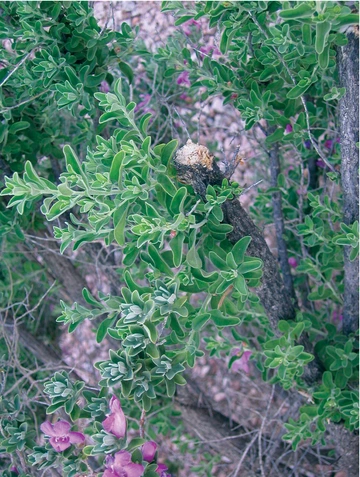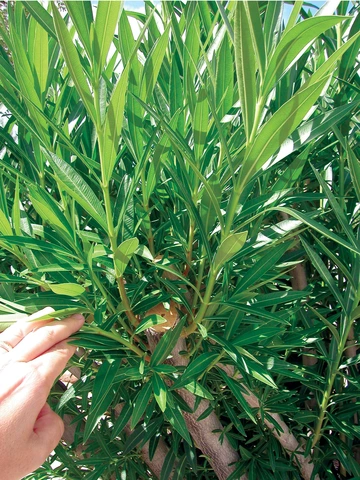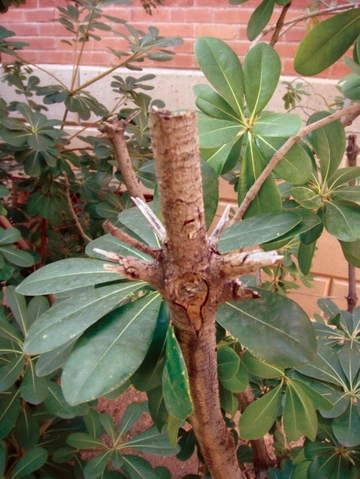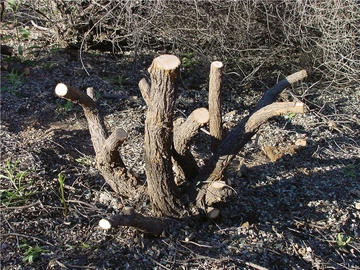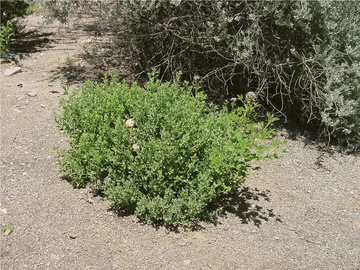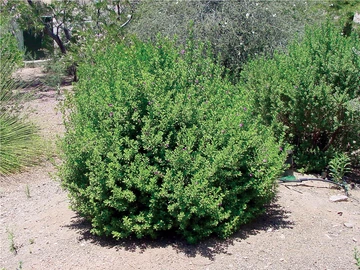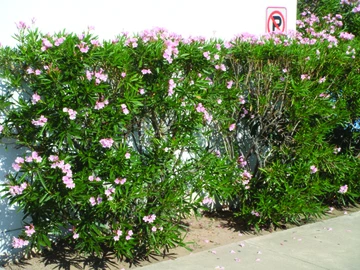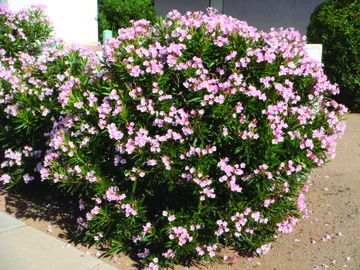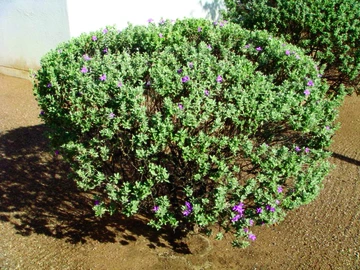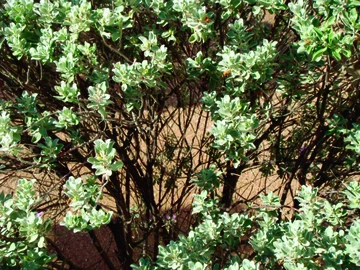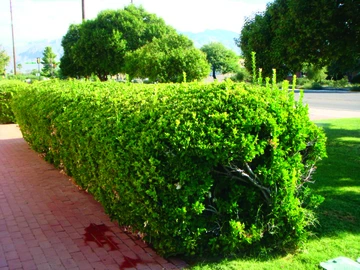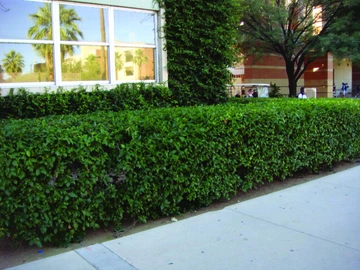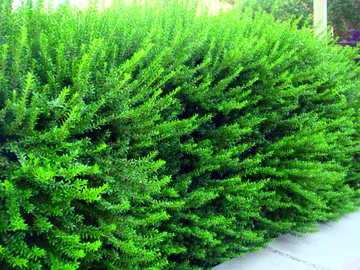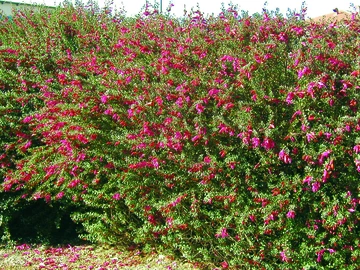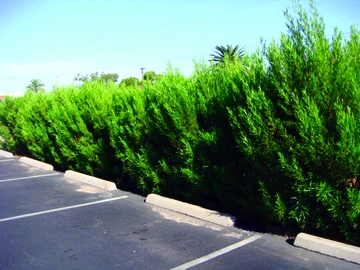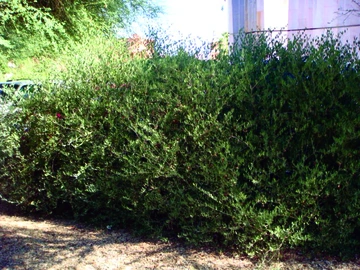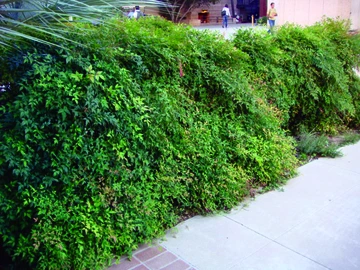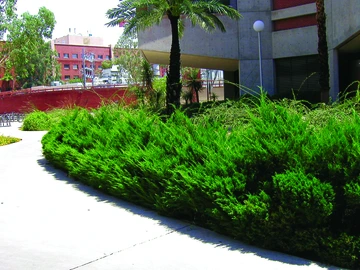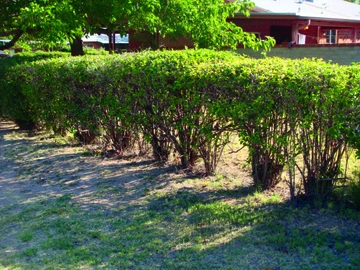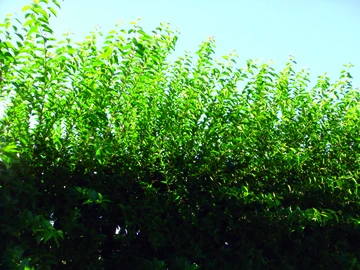Este material también está disponible en español.
Pruning is the intentional removal of parts of a plant. Pruning needs of shrubs commonly planted in the low and mid-elevation deserts in Arizona vary from no pruning to regular seasonal pruning. Requirements vary by plant species, design intent, and placement in a landscape. Fast growing shrubs generally need frequent pruning from the time of establishment until maturity, while slow growing shrubs require little to none. Pruning should only be done when necessary and at the right time of year. Using the natural growth form of a shrub is a good guide for pruning. Shearing shrubs should be avoided except for maintenance of formal hedges or plant sculptures. All pruning should be done with sharp hand pruners or, for thicker stems, loppers.
- Don’t prune unless necessary.
- Use the appropriate, sharp tool for the job.
- Prune at the right time of year.
- Use the natural growth form of the shrub as a guide for natural pruning.
- Shear only formal hedges.
Reasons for pruning shrubs include maintenance of plant health, controlling plant size (for preventing obstruction of a view, sidewalk, or driveway), and rejuvenating old plants. Maintaining plant health includes the removal of diseased, dying, injured and dead branches. Stems that rub against each other should be removed. Control of shrub size for visibility and safety concerns is sometimes necessary. These can be minimized by allowing sufficient space for the plant to reach its mature size in the landscape. Renovating or rejuvenating old or overgrown shrubs through pruning generally improves the structure and quality of the plant, and results in improved displays for flowering shrubs. Some shrubs are grown as formal hedges and require continuous pruning to maintain their size and shape.
Pruning techniques
Selective thinning
refers to removing branches back to the point of attachment to another branch, or to the ground. This type of pruning opens the plant canopy, increasing light and air movement (Figure 1). Thinning cuts do not stimulate excessive new growth. They serve to maintain the natural growth habit of the shrub. When light can penetrate the canopy, entire branches can maintain leaves whereas in a dense canopy branches have leaves near the tip but are bare further back. Selective thinning is suitable for all plants and is generally the most desirable type of pruning cut.
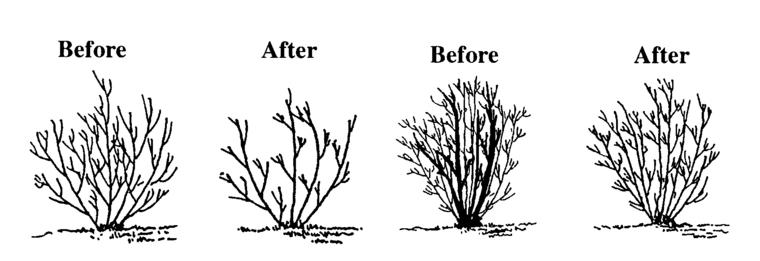
Figure 1. Selective thinning removes the branches back to the point of attachment (left) or to the base of the plant (right) and preserves the natural shape of the plant.
Heading cuts
remove parts of a stem or branch resulting in multiple new shoots just below the cut (Figure 2). This can create a bushy plant and is sometimes done whn plants are very young to stimulate more branches. However, repeated heading is similar to shearing and eventually results in a dense canopy with branches having leaves at the tip and no leaves further back. Heading cuts should only be used for formal hedges, for rejuvenation, or when a cluster of branches is desired. Stubs left by heading cuts will usually die back, unless cut just above a bud. No pruning or little pruning is required of some slow growing shrubs (Table 1). Such plants are ideal for low maintenance landscapes and include creosote, hop bush, Texas mountain laurel, Arizona rosewood, pomegranate, jojoba, and juniper. These shrubs should be planted where they can reach their natural size without interfering with other plants, structures, or lines of visibility. A yearly inspection can determine whether any corrective pruning is necessary, but generally these species will grow for many years with minimal maintenance.
Shrubs That Require Little to No Pruning
| Latin name | Common name |
|---|---|
Buddleja marrubiifolia | Wooly butterfly bush |
Dermatophyllum secundiflorum | Texas mountain laurel |
Dodonea viscosa | Hop bush |
Fallugia paradoxa | Apache plume |
Juniperus chinensis cultivars | Juniper |
Larrea tridentata | Creosote |
Ligustrum japonicum | Waxleaf privet |
Nandina domestica | Heavenly bamboo |
Pittosporum tobira | Japanese mock orange |
Rhus microphylla | Little-leaf sumac |
Rhus ovata | Sugar bush |
Rhus virens | Evergreen sumac |
Ruellia peninsularis | Desert ruellia |
Simmondsia chinensis | Jojoba |
Thuja cultivars | Arbovitae |
Vauquelinia californica | California rosewood |
Xylosma congestum | Xylosma |
Renovating or rejuvenating
Older or overly large shrubs extends their life and improves their aesthetic value. One method is to cut all stems about 12-18 inches above the ground. This is a severe measure and changes the appearance drastically (Figure 3). However, when done in spring before bud burst, a great proliferation of stems will grow just below each cut by mid-summer. At that time, about half of the stems should be removed and the remaining ones should be cut back to different heights. Varying the height and cutting just above an outward pointing bud will stimulate growth of new branches out of the canopy. This procedure works well for larger fast growing shrubs like Texas ranger, xylosma, and oleander and for slower growing shrubs like hop bush and creosote. Some shrubs such as cassias, arborvitae and junipers do not respond favorably to this treatment and might die. Rosemary is also not a candidate for this procedure. Thicker stems of older rosemary shrubs without needles should not be cut because they do not initiate new shoots behind the cut. The voids created by cutting woody stems of creeping rosemary will not be filled in by new growth. Several smaller shrubs such as brittle bush, autumn sage, and Mexican honeysuckle benefit from being cut to six inches above the ground annually. They don’t require any follow-up thinning of the new growth. Cutting frost-damaged plants back close to the ground after the danger of frost has passed in spring rejuvenates lantana and red bird of paradise.
A less severe approach to rejuvenating shrubs is to remove half or more of the older unproductive branches at the base of the plant or those growing into the canopy. This thins out the plant to a much greater extent than regular maintenance pruning. Follow-up care requires removing a portion of the new shoots a couple of weeks later, which might be too numerous and result in an overly dense canopy. The third method of rejuvenation spans three to four years and is less noticeable. About one third to a quarter of the oldest unproductive branches are removed each year. This method requires thinning excess branches and cutting back the remaining new branches as described before.
Shearing
shrubs entails cutting back branches to a uniform surface. This should not be done other than for formal hedges or special topiaries (Table 2). Shearing shrubs uses heading cuts and leaves stubs which results in proliferation of new dense growth just behind the cut. There are several reasons why shearing is not recommended other than for formal hedges (Figure 4, 5). Shearing is labor intensive and requires repeat shearing to maintain the shape. It destroys the natural growth habit and gives shrubs an unnatural look. It is difficult to control the plant height since the new dense growth shades the inside of the canopy which can defoliate for lack of light. Subsequent cuts into the new growth will shear close to the surface, but over time the dimensions of the canopy will increase. Cutting into the older, bare wood by shearing results in a leafless shrub, limits the plants ability to produce their own food, and depletes their reserves to grow new leaves. This stresses the plant and can result in decline or death. Regular shearing of shrubs removes flower buds, flowers, and destroys their natural form.
Plants Suitable for Formal and Informal Hedges
Latin name | Common name | Informal hedges | Formal hedges |
|---|---|---|---|
Buxus microphylla japonica | Japanese boxwood | + | + |
Ligustrum japonicum | Waxleaf privet | + | + |
Myrtus communis | Myrtle | + | + |
Simmondsia chinensis | Jojoba | + | + |
Xylosma congestum | Xylosma | + | + |
Juniperus chinensis cultivars | Juniper | + | + |
Carissa grandiflora | Natal plum | + | + |
Dodonea viscosa | Hop bush | + | |
Leucophyllum frutescens | Texas ranger | + | |
Leucophyllum laevigatum | Chihuahuan sage | + | |
Nandina domestica | Heavenly bamboo | + | |
Nerium oleander | Oleander | + | |
Punica granatum | Pomegranate | + | |
Thuja cultivars | Arbovitae | + | |
Vauquelinia californica | California rosewood | + |
Timing
The general guideline for pruning is after flowering shrubs have completed flowering (Table 3). Therefore, spring flowering shrubs like cassia or rosemary should be pruned in late spring. Summer or fall flowering shrubs like oleander, dalea, or Texas ranger should be pruned after flowering or in late winter to early spring. Spring flowering plants complete flower bud formation the previous year, therefore pruning in early spring will remove the current season’s flowers. Summer and fall flowering shrubs usually generate flowers on the current season’s new growth. They should be pruned either after flowering or before new growth resumes in spring. Selective pruning of a few branches can be done on most plants throughout the year. Some very vigorous growing shrubs like bougainvillea or firethorn need light pruning throughout the growing season, unless they are given ample space to grow naturally.
Frost-damaged plants such as bougainvillea and yellow trumpet flower should be cut back to living wood after all danger of frost has passed or when regrowth resumes. Red bird of paradise is generally cut back to six to ten inches above the ground. Lantana is cut back to just above the ground after frost danger has passed.
Pruning recommendations for flowering shrubs
Winter to Spring
Scientific name | Common name | Pruning |
|---|---|---|
Eremophila maculata | Emu bush | Prune lightly after flowering as needed. |
Spring
Scientific name | Common name | Pruning |
|---|---|---|
Feijoa sellowiana | Pineapple guava | Prune or shape in late spring. |
Encelia farinosa | Brittle bush | From second year on cut back to six inches after flowering. |
Euphorbia rigida | Gopher plant | Remove stems with flowers after fruit have set. |
Jasminum mesnyi | Primrose jasmine | Prune lightly after flowering as needed. |
Pyrancantha sp. | Firethorn | Prune after flowering in spring, during the growing season as needed, and in late fall. |
Rhaphiolepis indica | Indian hawthorn | Light pruning after flowering |
Rosemarinus officinalis | Rosemary | Frequent light pruning as necessary. Plants grow only back from leafy shoots, not from cuts in bare wood. |
Senna artemisioides Senna nemophila Senna phyllodenia | Feathery senna Green senna Silvery Senna | Little pruning required; remove seedpods after they are set, if desired |
Spring to Fall
Scientific name | Common name | Pruning |
|---|---|---|
Aloysia gratissima | Beebrush | Shape when dormant, otherwise light pruning as needed. |
Bougainvillea sp. | Bougainvillea | Prune dead wood or frost damage in early spring. Remove vigorous shoots as needed. |
Calliandra californica Calliandra eriophylla | Baja fairy duster Pink fairy duster | Light, natural pruning in late spring after first flowering. |
Cordia boissieri Cordia parvifolia | Texas olive Little-leaf cordia | Light pruning as needed to shape. |
Justicia spicigera Justicia californica | Mexican honeysuckle Chuparosa | Little pruning needed. Remove old woody stems to rejuvenate in late fall, and remove frost damage in spring. |
Lantana sp. | Lantana | Cut to ground after frost danger has passed. Prune anytime to control growth, if necessary. |
Nerium oleander | Oleander | Thin in spring or early summer or after bloom, remove old wood, but don’t shear. |
Spring and Summer
Scientific name | Common name | Pruning |
|---|---|---|
Carissa grandiflora | Natal plum | Remove frost damaged wood in early spring and vertical sprouts as needed. |
Dalea greggii | Trailing indigo bush | Cut back by half during winter dormancy first couple of years. |
Punica granatum | Pomegranate | Prune in late winter as needed to shape. |
Salvia clevelandii Salvia chamaedryoides Salvia greggii Salvia leucantha | Chaparral sage Blue sage Autumn sage Mexican bush sage | Cut back old stems in winter or early spring. Deadhead spent flower stems. For vigorous species cut back again after flowering in summer. |
Dalea greggii | Trailing indigo bush | Cut back by half during winter dormancy first couple of years. |
Punica granatum | Pomegranate | Prune in late winter as needed to shape. |
Salvia clevelandii Salvia chamaedryoides Salvia greggii Salvia leucantha | Chaparral sage Blue sage Autumn sage Mexican bush sage | Cut back old stems in winter or early spring. Deadhead spent flower stems. For vigorous species cut back again after flowering in summer. |
Summer to Fall
Scientific name | Common name | Pruning |
|---|---|---|
Caesalpinia gilliesii Caesalpinia mexicana | Desert bird of paradise Mexican bird of paradise | Major pruning in late winter or early spring; cut stems of C. pulcherrima six inches above ground. Light midsummer pruning to control size, if needed. |
Caesalpinia pulcherrima | Red bird of paradise | |
Leucophyllum candidum Leucophyllum frutescens Leucophyllum laevigatum | Violet silverleaf Texas ranger Chihuahuan sage | No pruning needed if planted in appropriate space. Selective pruning in early spring. |
Thevetia peruviana | Yellow oleander | Prune in early spring, remove frost damaged branches. |
Caesalpinia gilliesii Caesalpinia mexicana | Desert bird of paradise Mexican bird of paradise | Major pruning in late winter or early spring; cut stems of C. pulcherrima six inches above ground. Light midsummer pruning to control size, if needed. |
Caesalpinia pulcherrima | Red bird of paradise | |
Leucophyllum candidum Leucophyllum frutescens Leucophyllum laevigatum | Violet silverleaf Texas ranger Chihuahuan sage | No pruning needed if planted in appropriate space. Selective pruning in early spring. |
Fall and Fall to Spring
Scientific name | Common name | Pruning |
|---|---|---|
Dalea bicolor Dalea lutea | Indigo bush | Prune those vigorous species by one third to half during winter dormant period. |
Dalea frutescens | Black dalea | Prune in late winter. |
Hedges
Hedges are used as a screen or in place of a fence. A formal hedge is sheared into a geometric shape by cutting the sides and top. Informal hedges use shrubs in their natural growth habit and maintain the general shape through selective thinning or heading back of individual branches. Plants with small internodes (short distance between leaves) are most suited for hedges which should have a dense canopy (Table 2). Myrtle, Japanese or waxleaf privet and xylosma tolerate frequent shearing and are good candidates for formal hedges (Figure 6). Oleander, hop bush, heavenly bamboo, pomegranate, and arbovitae cultivars are examples of plants suitable for informal hedges (Table 2, Figure 7). Keeping the mature plant size in mind is an important consideration when choosing a species for an informal hedge. Some oleander cultivars can grow as tall as 20 feet while the petite varieties will grow only two to three feet tall.
Formal hedges are trained soon after planting. At this time they require cutting off the top third of the plant to induce more branches. The next year half of the new growth is sheared to induce more branching and a full canopy. By the third year hedges are often shaped into the desired form, however this depends on the final size and growth rate of the shrubs used. This might be earlier for low hedges or later for taller ones. The base of a hedge should be slightly wider than the top to allow light to reach the lower branches. Hedges that are kept incorrectly narrower at the bottom than the top will often lose their leaves on the lower branches (Figure 8). The top half of hedges can be rounded, peaked or flat. New shoots that grow out of a formal hedge require follow-up trimming (Figure 9). Formal hedges should be cut only a few inches at a time, otherwise leafless branches may become visible. Maintenance of established hedges usually starts after spring growth is completed. Follow up depends on the species and the level of formality desired. Old, overgrown hedges can be rejuvenated, as discussed before, provided the shrubs respond well to severe cutback. Formal hedges are time consuming to maintain compared to informal hedges, which are allowed to grow in their natural form and need very little maintenance.
Training large shrubs into small trees
Some shrubs can be trained into small trees. Shrubs that naturally grow to a larger size are suitable for this manipulation. They include Arizona rosewood, Texas olive, Texas mountain laurel, oleander, waxleaf privet, and xylosma (Figure 10, 11). This process should be initiated when shrubs are small and at this time they are trained as either a single trunk or a multi-stem tree. Multi-stem trees are best to accommodate the natural form of large shrubs. For a single trunk tree a straight central leader needs to be selected early. Training is complete when the plant reaches mature size. Regular follow-up maintenance is usually required to keep the trunks free of new adventitious shoots and the base free of suckers. Plants vary in their requirements for selective maintenance. Single stem oleanders demand very frequent removal of sucker growth from the base.
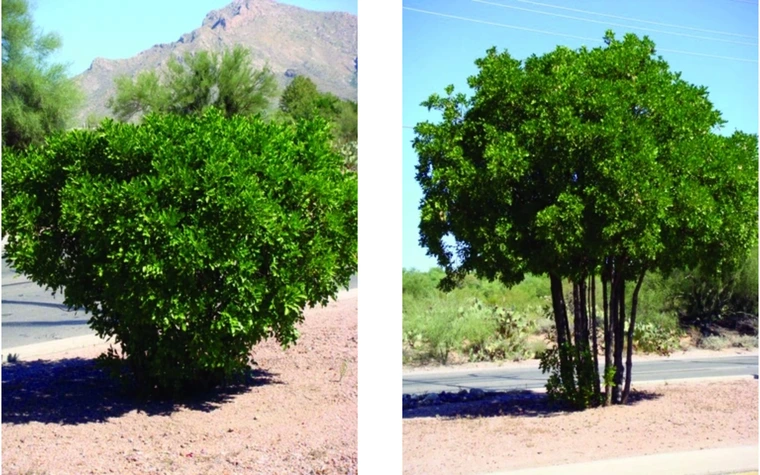
Figure 10. Texas mountain laurel is a slow growing shrub that can be trained into a small multi-trunk tree.
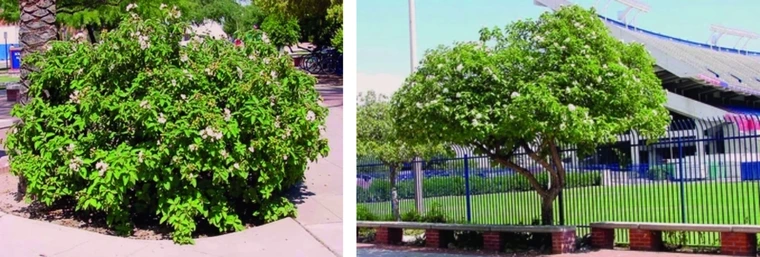
Figure 11. Texas olive can be grown as a shrub or trained into a tree.
References
Brenzel, K.N. 2012. The New Sunset Western Garden Book, 9th Ed., Time Home Entertainment Inc., New York, New York.
Duffield, M.R. and W. Jones. 2001. Plants for Dry Climates. Perseus Publishing, Cambridge, MA.
Johnson, E.A. 1997. Pruning, Planting, and Care. Ironwood Press, Tucson, AZ.


